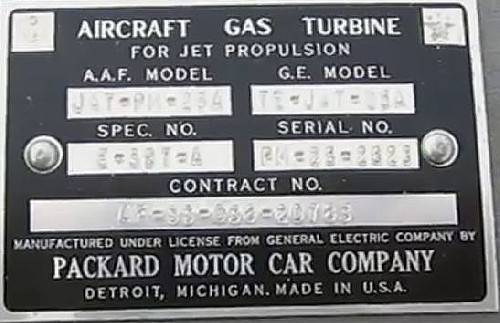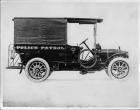|
The Atomic Packard returns
|
||||
|---|---|---|---|---|
|
Home away from home

|
At PackardInfo.com we already have experiences with atomic Packards. Be it a king-sized vehicle in charge to mobilize J. Robert Oppenheimer and colleagues to win the race for the bomb against the Third Reich - thanks to DanL (41ParPack) who kept us informed - or the single-wheeled Studebaker-Packard Astral.
This post, to be taken with a grain of salt, will make an effort for a remake. The wording "atomic Packard" suggests that the talk revolves around an atomic-powered vehicle, an unfulfilled pledge so far. Today I will take the risk to raise the bar: If Packard has ever been involved in a real atomic-powered vehicle then it probably could fly! Now a short break in silence fraught with menace to allow the commanders of the Packard history guard battalion to position forces. Attach file:  (19.94 KB) (19.94 KB)
Posted on: 2011/9/10 17:41
|
|||
|
The story of ZIS-110, ZIS-115, ZIL-111 & Chaika GAZ-13 on www.guscha.de
|
||||
|
||||
|
Re: The Atomic Packard returns
|
||||
|---|---|---|---|---|
|
Forum Ambassador

|
Astral?
Never heard of such a thing. 
Posted on: 2011/9/11 8:53
|
|||
|
||||
|
Re: The Atomic Packard returns
|
||||
|---|---|---|---|---|
|
Home away from home

|
They just needed to mount a Mr. Fusion on their Packard.
Attach file:  (27.54 KB) (27.54 KB)  (11.14 KB) (11.14 KB)
Posted on: 2011/9/11 10:12
|
|||
|
||||
|
Re: The Atomic Packard returns
|
||||
|---|---|---|---|---|
|
Home away from home

|
Brian, the die is cast.
 Don, Packard as inventor of the flux capacitor would be a new hypothesis. At least one thing both stories have in common: where they're going, they don't need roads! Ok, here we go. At the beginning I would like to delve into the subject of Packard war effort, feel free to fill in the numerous gaps.  source: flicr.com Nuclear-free prologue in order to get attuned Thanks to John (JW), Stephen, Dave (Owen_Dyneto) and Guy (packardguy53) we sometimes talk about how Packard once ruled the airspace. Every once in a while the famous diesel aircraft engines becomes for the House, the liberty engine and of course, the Merlin.  A Liberty engine undergoes testing on a dynamometer. Liberty engines powered the LUSAC-11 on record-setting flights. (Photo courtesy ASCHO) Did you know that a Merlin consists of around 14,000 parts, at the begin of the war assembled by hand according to Rolls-Royce standards and work methods? [source:outlawpulling.com/PDF/Packard%20Marine%20Engine.pdf]  Aircraft mechanics attend a demonstration of the Rolls-Royce Merlin engine at the Rolls-Royce Ltd. premises at Derby. [US National Archives] There have always been illustrious names and brands around the epicenter like Rolls-Royce, Mustang and Spitfire. Not to forget the Packard powered airships.  source: flicr.com And last but not least the truck production has to be mentioned, the navy motorization and finally even tank engines but I did no research on this because this thread looks to the sky activities.  Packard 1 1/2 Ton truck Photo: From the Eisenhower collection, taken during the 1919 Transcontinental Motor Convoy.
Posted on: 2011/9/11 12:37
|
|||
|
The story of ZIS-110, ZIS-115, ZIL-111 & Chaika GAZ-13 on www.guscha.de
|
||||
|
||||
|
Re: The Atomic Packard returns
|
||||
|---|---|---|---|---|
|
Home away from home

|
Intermezzo, still nuclear-free
The previous post was intended to show you that Packard has been not only a car manufacturer but was additional involved in military goods, was an important war contractor and always looking for public orders. The sometimes mentioned proving grounds in Michigan additionally served as tank testing facility. Who would doubt that a Merlin is a power of its own? To interlace its war history with the history of Detroit and embed its fabrication in the financial context of the Packard Motor Car Company I warmly suggest the article "The car that won the air war over Europe" by John W. Lawrence (JW), who's always on the spot when it comes to flying Packards.  picture source: www.spitfiresite.com And who would doubt that the Packard marine engines have been a power of their own? The supercharged V-12 marine engines had their roots not in UK but in mid 1920s Packard liberty aircraft engines. Their performance ranged from 1100 h.p. at the begin of the war and reached even 1500 h.p. after several improvements. To delve into the subject I recommend this source (based on reseach results of Robert Neal): outlawpulling.com/PDF/Packard%20Marine%20Engine.pdf But as the headline promised this thread will deal with more powerful drivetrains than Liberty and Merlin. Much more powerful drivetrains! On its way to the forces of nature Packard played with, this post shall be a cross between conventional engines and infernal machines. To convey a first impression of the things I have in mind I would like to show you a suitable photo - click to enlarge if not already impressive enough.  A probably Packard driven vehicle; picture source: www.johnweeks.com Packard was a license builder for jet engines and even a jet engine developer!
Posted on: 2011/9/23 0:54
|
|||
|
The story of ZIS-110, ZIS-115, ZIL-111 & Chaika GAZ-13 on www.guscha.de
|
||||
|
||||
|
Re: The Atomic Packard returns
|
||||
|---|---|---|---|---|
|
Home away from home

|
Packard employees with X-ray protective apron
To understand the volume of the air activities please check this general overview. In 1917 Packard ruled the air space. Well, "ruled" sounds like an exaggeration. But please take into consideration that in times when Packard built more than 5,000 twelve-cylinder aero engines the US airforce consisted of modest 23 air planes. 30 years later: "...Packard's investment for production of the new turbojet engine design was extensive. By the end of 1946 the installation of fabrication and testing equipment was valued at $10,000,000. In addition, flight testing, shop and hanger facilities at Willow Run, Michigan was valued at $1,000,000, and an additional $3,500,000 in laboratory and testing equipment was installed by spring of 1947..."[Robert Neal, quoted in wikipedia]. Harold Vance, who is mentioned in "The fall of the Packard Motor Car Company" as the Studebaker-Packard vice-president in charge of production and engineering held a seat on the atomic energy commission. From there it wasn't very far to hire a group of ten engineers to develop a nuclear heated gas turbine. The story started years earlier... <iframe width="480" height="360" src="http://www.youtube.com/embed/S86zRMehs-A" frameborder="0" allowfullscreen></iframe>
Posted on: 2013/3/9 14:52
|
|||
|
The story of ZIS-110, ZIS-115, ZIL-111 & Chaika GAZ-13 on www.guscha.de
|
||||
|
||||
|
Re: The Atomic Packard returns
|
||||
|---|---|---|---|---|
|
Home away from home

|
Have you ever heard of the Studebaker-Packard Nuclear Power Department? --> That's one of their work results:
AECU-3559 REACTORS-POWER UNITED STATES ATOMIC ENERGY COMMISSION GAS COOLED NUCLEAR REACTOR STUDY Final Report By A. S. Thompson July 31, 1956 Nuclear Power Department Studebaker-Packard Corporation Detroit, Michigan [source:osti.gov/bridge/product.biblio.jsp?osti_id=43406199] <iframe width="480" height="360" src="http://www.youtube.com/embed/m614VDfJ9oU" frameborder="0" allowfullscreen></iframe>
Posted on: 2013/3/10 1:30
|
|||
|
The story of ZIS-110, ZIS-115, ZIL-111 & Chaika GAZ-13 on www.guscha.de
|
||||
|
||||
|
Re: The Atomic Packard returns
|
||||
|---|---|---|---|---|
|
Home away from home
|
Hello All,
Here is an important fact I was not aware of when I wrote the article several years ago. The U.S. Army Air Force had an aircraft that would have functioned well as a high-altitude long-range bomber escort in the early days of the bomber war against Nazi Germany. It was the Lockheed Lightening P-38. The P-38s were powered by two liquid cooled, turbo supercharged Allison V-12 engines. Unfortunately, this airplane had a couple of problems that kept it from being a major player in the bomber escort role. First, was the reluctance of the USAAF to use auxillary fuel tanks for extended range. This thinking was later changed when the Mustang was tapped for the escort role. Next, and more serious, was the air flowing over the wing sections between the engines and the fuselage would go supersonic when the plane was in a high-speed dive from high altitude. This condition would result in a loss of control and the plane would crash. In some situations this condition could have been overcome if the pilot would have waited until the airplane got down to lower altitude and thicker air where control could have been restored. This would have taken a very brave pilot and one who knew what was going on. As these crashes increased, the P-38 was withdrawn from escort duty. Lockheed quickly figured out what was going on and designed and built a kit to be installed on the aircraft in theater. Basically, the kit consisted of an air brake to disrupt the air flow and prevent it from going supersonic. The kits were loaded on a transport for shipment to England. The transport crashed enroute and all the kits were lost. The Lightenings were withdrawn from high altitude service and the bombers suffered tremendous losses because of the lack of fighter escort to and from the targets. Later the RAF fitted one of their Mustangs with a Merlin and quickly realized the potential of this combination. The AAF grabbed on to this, and starting with the "C" versions equipped their Mustangs with the Merlins and drop tanks. The rest, they say, is history. It needs to be noted that the P-38 served well in low altitude support roles in North Africa and Europe. It also had a notable record in the Pacific with its long range and performance. I wonder what history would have been like if the P-38s had been fitted with drop tanks and retrofitted with the kits. Surely, there would have been far less bomber losses. Thanks (o{}o)
Posted on: 2013/3/10 12:05
|
|||
|
We move toward
And make happen What occupies our mind... (W. Scherer) |
||||
|
||||
|
Re: The Atomic Packard returns
|
||||
|---|---|---|---|---|
|
Forum Ambassador
|
Very interesting histories and particularly the bit that the US paid RR a royalty for the Packard built Merlins. As I understand it, even if they were not under threat or actually being bombed, RR couldn't meet anywhere close to the demand even for their own use. The US and Packard step up and makes it a winning situation for both US and British planes. Then we pay them for the privilege of doing so along with the vast quantity of other war material loaned and then forgiven. Well, at least there is a precedent for the vast quantity of recent money being spent on other countries.
Posted on: 2013/3/10 12:47
|
|||
|
Howard
|
||||
|
||||












